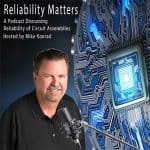
Podcast Listens
Abstract
Kirk and Fred discuss the almost 10 years of Speaking of Reliability podcasts and podcasting in general.
Your Reliability Engineering Professional Development Site
by Greg Christensen Leave a Comment

This CMMSradio episode features Tony Demakis, the host of the Manufacturing Alliance podcast and a representative of Alliance Specialties and Laser Sales. The episode dives into Tony’s journey from reluctant involvement in his father’s 46-year-old company to becoming a leader who emphasizes employee empowerment and open communication. Tony discusses the importance of preventative maintenance in manufacturing, leadership practices, the skilled trades gap, and the value of hands-on learning in engaging the next generation. He also highlights the significance of work-life balance and making a difference in the lives of others.
Key Topics:

Kirk and Fred discuss the impact of early life failures on the customer ᐅ Play Episode
by Greg Christensen Leave a Comment

Inspired by a recent post, called Embrace the Fakeness, we’re joined by Dan Anderson of ReliabilityX to talk about the realities of software, like CMMS and EAM, and how magic silver bullets are the stuff of fantasy worth avoiding! Dan really gets it and we’re honored to get his unabashed insights on how to add value in the maintenance and reliability space for clients in need!!
Connect with Dan on LinkedIn and find ReliabilityX here: https://reliabilityx.com/
by Fred Schenkelberg Leave a Comment

Product teams often face decisions where uncertainty meets cost, and the clock is ticking.
That’s where expected value shines. It’s a lightweight decision tool that translates probability and impact into a single, comparable figure.
More important, it pairs nicely with a simple three-phase flow (frame it, investigate it, choose it) so your decision is not a hunch, but an informed step tied to evidence and project priorities.
by Ansumi de Bruin Leave a Comment

Andrew Daddo sat down with Dr. John L. Ross Jr., a 30-year veteran in maintenance and reliability, former Air Force captain, and founder of both the American Reliability and Maintenance Institute and Maintenance Innovators, his primary company of 17 years. Dr. Ross shared insights on leadership in maintenance and reliability, emphasizing that true change requires more than simply replacing leadership—it’s about fundamentals. He used the analogy of growing an apple tree to highlight that the right conditions (seed, nutrients, sunlight) are essential, just as in business, where you need the right leadership, tools, and approach to thrive.
He explained how leadership has evolved from a top-down, authoritarian model to one of inclusion and accountability. Drawing from his extensive experience, Dr. Ross described how today’s workforce, with access to technology and higher education, requires a different leadership style—one that involves engaging employees, valuing their input, and fostering a sense of ownership in the decision-making process.
Dr. Ross highlighted the importance of building leadership skills, rather than simply managing people and processes. He noted that creating an inclusive culture where everyone’s input is valued can significantly improve morale and lead to better outcomes. Finally, he discussed the significance of conferences like MAINSTREAM, where industry leaders can exchange fresh ideas, learn best practices, and inspire real change in their organizations. [Read more…]
by Greg Christensen Leave a Comment

A special mini episode featuring Katie Sanders of #upkeep chopping it up about Women in Manufacturing as a part of celebrating Women in Construction this week!
The episode hits the feed tomorrow morning!! This matters! 🤘🤘🤘
Thank you for an awesome visit, Katie!! Keep up the great work and we’re all here to support #WiM!! 🤘🤘🤘
Katie is also CMMSradio Correspondent 1 as of June 2025!
by Enrico Belmonte Leave a Comment

Enrico and Fred discuss an array of problems that may arise with reliability testing.
ᐅ Play Episode
by Greg Christensen Leave a Comment

In this episode of CMMSradio, Greg Christensen welcomes William Sloan from Eruditio to discuss the integration of MRO and CMMS systems. Sloan shares insights on the advantages of this integration, the role of end-user involvement, and the cultural challenges organizations face when adopting new systems.
Key topics covered:
The benefits of integrating MRO and CMMS systems for smoother operations.
The importance of utilizing CMMS features that are often overlooked.
Improving data quality and contextual information through integration.
Overcoming resistance to change and the role of end-user input in CMMS selection.
The value of pilot testing and learning from failures for successful adoption.
Check out iBL from Eruditio here: https://www.eruditio.com/ibl_Curriculum
by Christopher Jackson Leave a Comment

Chris and Fred discuss the product design process commonly called build, test, fix.
ᐅ Play Episode
by Greg Christensen Leave a Comment

This AI Assistant is the real deal.
Alex Cummings, CEO of FlowPath CMMS, returns to CMMSradio with an update on the release of AI Assistant throughout the platform – top to bottom. We discuss why it matters, who this helps, how it helps, and the legitimate outcomes this AI drives for clients! The best part – It’s real and eliminates challenges to ongoing system use while not cutting any corners. It helps FlowPath clients continuously improve in their operational and maintenance maturity.
Setup a call/demo: https://www.getflowpath.com/cmmsradio
by Greg Christensen Leave a Comment

We’re joined by Nathan Wright
Career: Nathan Wright has over four decades of experience across industries like manufacturing, mining, and heavy equipment, starting with maintenance in the US Navy.
Real-World Experience in Leadership: Nathan highlights the importance of hands-on experience in maintenance leadership and how it complements academic knowledge.
CMMS and Manufacturing: The episode covers CMMS systems’ role in sustainable manufacturing, emphasizing proactive maintenance and proper system implementation.
Leadership and Communication: Nathan discusses the critical role of effective communication and leadership in maintenance teams and operational efficiency.
Grab a copy of The Wright Leader, Nathan’s book, on Amazon and look into Transformational Performance Solutions here: https://tps-solutions.com/
by Mike Konrad Leave a Comment

Since 2018, Reliability Matters has been building a knowledge vault, capturing the wisdom of industry experts for engineers everywhere.
In this special year-end episode, we celebrate the journey, the growth, and the community that made it possible.
by Christopher Jackson Leave a Comment

Chris and Fred discuss a listener’s question on whether or not to study statistics.
ᐅ Play Episode
by Greg Christensen Leave a Comment

Matthew Beach joins CMMSradio to talk about maintenance, maintenance management, reliability, and CMMS!! Inspired by some posts on LinkedIn and a bit of comment trading we wanted to connect for a grip it and rip it style conversation! That’s what we do!!
Thanks for joining, Matt! A fun and useful conversation indeed! Thanks to our followers and supporters. Follow @cmmsradio for more episodes and feel free to connect with our company page on LinkedIn here: https://www.linkedin.com/company/cmms…
 Ask a question or send along a comment.
Please login to view and use the contact form.
Ask a question or send along a comment.
Please login to view and use the contact form.